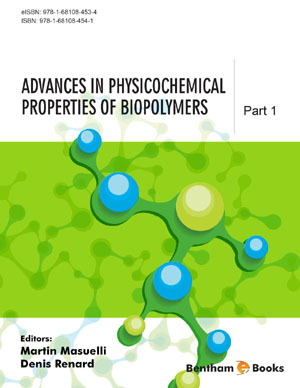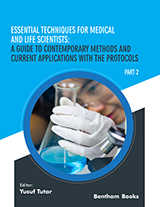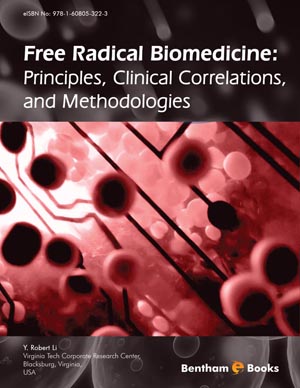Application of Mass Spectrometry in Proteomics
Page: 1-29 (29)
Author: Serap Pektas
DOI: 10.2174/9781681087092118010004
PDF Price: $15
Abstract
Mass spectrometry (MS) is a powerful tool to study biological samples both qualitatively (structure) and quantitatively (molecular mass). In recent years with the improvement of soft ionization techniques and the development of new methods, its application in proteomics, microbiology and clinical laboratories has increased. Especially in proteomics laboratories, it is commonly used for determining protein amino acid sequence, identification of post translational modifications, determining protein-peptide/protein/DNA interactions, determining protein folding and unfolding rates etc. In microbiological laboratories, MS is mainly used to identify microorganisms such as bacteria and fungi. Even though its use in clinical laboratories still needs improvement of methods, it can be used for diagnosis of disease, identification of metabolic disorders, discovering new biomarkers and identifying drug toxicity. This chapter provides a general review of MS applications in proteomics.
Structural Elucidation of Macromolecules
Page: 30-91 (62)
Author: Ana Luisa Carvalho, Teresa Santos-Silva, Maria Joao Romao, Eurico J. Cabrita and Filipa Marcelo
DOI: 10.2174/9781681087092118010005
PDF Price: $15
Abstract
While the structures of many proteins and nucleic acids are known and available in the Protein Data Bank, the folding and active sites of many fundamental macromolecules are yet to be elucidated. However, structure determination is only a small part of the story; to fully understand the diversity of functions that macromolecules have in living systems, interactions have also to be considered. Most drugs interact with macromolecular targets and the understanding of ligandmacromolecular recognition is fundamental in medicinal chemistry either from a purely structural viewpoint or by considering other important effects such as: ligand and binding site dynamics, distortion energies, solvent interactions and entropy. This chapter provides a comprehensive view on the several methods that are nowadays used to obtain structural information about macromolecules and their interactions with small ligands. The methods presented encompass different levels of characterization, either coarse information about the 3D shape or detailed structural data at the atomic level. Furthermore, relevance is given to the structural characterization of ligand binding events, either from the ligand or from the macromolecule viewpoint. Some experimental details behind X-ray crystallography, Nuclear Magnetic Resonance (NMR) and Small Angle X-ray Scattering (SAXS) are described, with examples and applications. An overview on Cryo-Electron Microscopy (CryoEM) is also presented. These are common state-of-the-art tools that truly complement each other and should be used in an integrative way.
Isothermal Titration Calorimetry
Page: 92-108 (17)
Author: Ozlem Ustun Aytekin, Elvan Yilmaz Akyuz, Banu Bayram, Esen Tutar, Halime Hanım Pence and Yusuf Tutar
DOI: 10.2174/9781681087092118010006
PDF Price: $15
Abstract
Isothermal titration calorimetry (ITC) is a versatile and easy to use technique to study macromolecular interactions. Macromolecules interact with each other to perform biochemical functions. These interactions are commonly based on proteinligand binding interactions and may occur among peptide, DNA, RNA, lipid, carbohydrate, ion, antibody, and enzymes. ITC experiments are relatively easy to perform, and no labelling is required for the set up. Performing an ITC experiment not only gives binding parameter but also it provides thermodynamic data. Further, the thermodynamic data provides nature of the interaction at molecular level i.e. hydrogen bonding, hydrophobic interactions. Cooperativity of ligands and binding specificity of each site may be determined by this technique. Molecular weight range, number of interacting molecules, and optical clarity limit most of the instrumental techniques but ITC is not affected by these limitations. All these benefits make ITC a common method to determine binding constants. A combination of the technique with complementary methods augments its benefits in detecting molecular mechanism.
Reverse Transcription Polymerase Chain Reaction (RT-PCR)
Page: 109-118 (10)
Author: Venkidasamy Baskar and Sathishkumar Ramalingam
DOI: 10.2174/9781681087092118010007
PDF Price: $15
Abstract
RT-PCR is a rapid and highly sensitive method to study the gene expression. RT-PCR includes the reverse transcription of RNA into cDNA and PCR. In RT-PCR, RNA is used as a template rather than DNA. Total RNA or poly (A) RNA can be used as a template for cDNA synthesis. RT reactions include primers (random primers/oligo dT/gene specific primers), reverse transcriptase and reaction buffers. RT-PCR can be performed either in one step or two step formats. In one step RT-PCR, reverse transcription and PCR were carried out sequentially in a single tube. However, in two step RT-PCR, RT reaction was performed separately, and one tenth of the RT reaction is used for PCR. In order to perform the semi-quantitative gene expression analysis, RT-PCR results will be subjected to the densitometry scanning and image J software analysis. RT-PCR is a powerful technique used in the various fields such as medical diagnostics, forensics and gene cloning. In this chapter, we have described the methodology, applications and the possible troubleshooting guide to be carried out during the RT- PCR experiment.
Introduction
This book provides a single platform for beginners in systems engineering to start Arduino interface projects with MATLAB®. It covers the basics of the programming with Arduino and Arduino interfacing with MATLAB® (with and without the use or I/O packages) in 3 sections, respectively. Key features: -introduces readers to Arduino IDE, Proteus simulation modeling, Arduino interfaces with display devices, sensor interfaces (both digital and analog), actuators, MATLAB® GUIs, digital read/write systems with I/O interfaces and automation systems. -organized layout for a reader friendly experience -provides detailed circuit diagrams -provides relevant simulation modeling instructions This is an ideal book for engineering students and system designers for learning the basic programming and simulation of Arduino and MATLAB® based real time project prototypes.

















